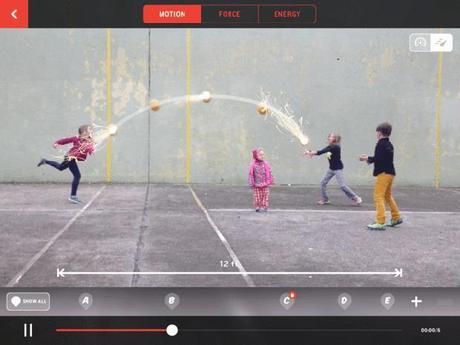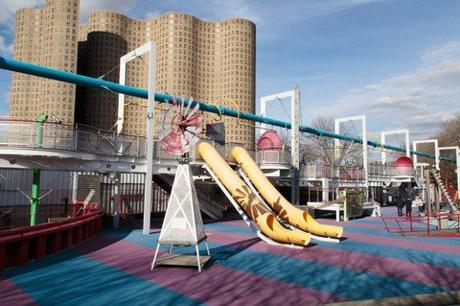On a breezy spring afternoon at the New York Hall of Science in Queens, designer Jake Barton is watching a pair of middle schoolers chuck an iPod across a playground while another kid films the scene with an iPad. This is the physics lesson of the future, and it looks like a blast.
Barton’s media design firm, Local Projects, has spent the past two years working with SciPlay, a research center launched by the New York Hall of Science in 2010, to use play to help kids learn scientific concepts. Local Projects is designing a suite of apps for SciPlay to leverage the way kids naturally play to create a social, engaging education platform that can fit in with Common Core principles for middle school math and science. The as-of-yet-unnamed SciPlay app which Barton and his team are testing on this particular day is a “digital noticing tool” that acts like a microscope revealing the hidden physics of kids’ everyday activities like throwing a ball. “Playgrounds are essentially machines to induce Newtonian physics on our own bodies,” Barton explains. “There’s math and science inside these things you already like to do. You just haven’t had a platform that can reveal it to you.”
Kids are always on their phone and iPads. Instead of trying to divorce education from that, let’s lean into it.
The app is an attempt to address one of the major issues facing educators (and the economy) today: how to get more kids interested in STEM. Research has shown that kids’ interest in science tends to decline over the course of middle and high school. That lack of interest has significant economic consequences. According to the White House, STEM jobs, are what will help the U.S. “win the future.” These jobs are projected to grow by 17% in the next decade, compared to less than 10% for other occupations, according to a report by the Department of Commerce. A diverse range of players is invested in bolstering STEM education: In addition to support from SciPlay (officially the Sara Lee Schupf Family Center on Play, Science and Technology Learning, thanks to a $1.5 million gift from the baked-goods heiress), the SciPlay app has gotten funding from a U.S. Department of Education grant, the John D. and Catherine T. MacArthur Foundation, Motorola Solutions Foundation, and the Bank of New York-Mellon Foundation.
The SciPlay app, says SciPlay director Harouna Ba, is “good for teachers to have in their arsenal.”
How It Works
The SciPlay app is essentially an annotated video: Using an iPad, you film motion–running, jumping, swinging, sliding, throwing a ball, etc.–and the app visualizes the basic science at work, pinpointing moments and levels of velocity, acceleration, energy, and force. Through manually tracing the arc of motion of the ball or person, or by using sensor data from the iPod attached to a ball or a kid’s belt, it superimposes the force diagrams that make up the backbone of any classroom physics lesson on real-life situations.
This is the physics lesson of the future, and it looks like a blast.
Today is one of many test sessions with a group of middle schoolers. Earlier in the afternoon, in one of NYSCI’s classrooms, the kids brainstormed a list of things they want out of app design, like “nice graphics” that are “not too cluttered.” Outside, they film each other running, jumping, clambering up a spider-web tangle of ropes and tossing a ball back and forth. The iPod fits snugly into a special foam ball, connecting to the SciPlay app via Bluetooth.

Broadening STEM Appeal
“I think sometimes technology does a better job of showing [physics] than actually having someone talk about the concept,” Ba says. “Some of these concepts–motion, force–they are very complex scientific concepts to teach. They’re just hard.”
Getting kids to play outside, on the other hand, is relatively easy. “Natural play is intrinsically motivating for children,” says Ba, who holds degrees in psychology and sociology.
Harnessing playing as a motivator, rather than approaching physics concepts in a more pedagogical way, can help science learning reach a broader audience. Ba says he’s noticed that kids, especially those from underserved communities, can get intimidated by technical scientific tools like microscopes. “They’re like, ‘I don’t want to touch this; it’s too expensive,’” Ba says. “We’re trying to invite them into science learning in a very playful way. It’s not school, where they’re just sitting there listening to someone talking.” The STEM fields have a well-documented problem with diversity, and making science feel accessible to kids of all backgrounds is an important step toward fixing that.

Prototype-First Design
Making science accessible is not a simple task. In the 17-odd months Local Projects and SciPlay have spent on research, design, and development, the app has changed dramatically.
Local Projects tried to get a working app into testing as soon as possible, working out design issues as the project progressed. “Sitting with a bunch of adults and arguing about what’s going to be most effective for kids is just sort of self-defeating,” Barton says. “We just build stuff and have people use it as fast as possible.”
We just build stuff and have people use it as fast as possible.
An early prototype used sensors embedded into mats with different levels of friction that kids would sit on as they went down the slide. The sensors would calculate how much thermal and kinetic energy was generated by their ride. Eventually, this design became cumbersome–it couldn’t visualize jumping or running, and required an awful lot of equipment. The app’s interface, filled with cartoon-y illustrations of playground slides, was a little abstract.
Now, the app is much more freeform, capturing any activity through video and extrapolating the physics based on given information like the depth of field and mass of the person running or jumping.
The designers are careful to frame the SciPlay app as an exploration tool, rather than a method of top-down learning. They wanted it to feel like a game that happened to teach you scientific concepts, not a mobile lesson plan. “From a UX standpoint, the toughest battle is how to make a platform that’s really open so kids can use it, but has sort of hooks and constraints so it’s actually driving towards revealing parts of the world through science or through mathematics,” Barton says.
The solution was to make the app a kind of “smart microscope.” You point it at things, and it shows you something you couldn’t see before, like the exact speed of your run. “Kids are prone to be on their phone and their iPads, prone to sharing things and making things. Instead of trying to divorce education from that, let’s lean into that,” Barton says.
The designers wanted it to feel like a game that happened to teach you scientific concepts.
The desire for self-documention actually presents something of a challenge: kids love to be filmed, but aren’t always super excited about doing the filming. “They’re super stoked, especially when they’re being active,” Eric Mika, a Local Projects developer explains. “We’re having a little bit of a harder time selling the camera angle.” Three middle school kids gathered on the playground the day I visited the New York Hall of Science were eager to toss the ball and clamber high up on the playground’s spiderweb of ropes, but unless someone instructed them otherwise, they largely left the filming to the adults.
This obstacle doesn’t seem to faze Barton. “This is the thing where I know we’re on the right track,” he says, watching the kids run around, yelling and tossing the ball with a SciPlay employee. “Because they’re having fun. They’re engaged.”

In The Classroom
After Local Projects finalizes the app’s design this fall, the SciPlay app will undergo a one-year testing period in classrooms. The plan is to integrate the app into public and private school curricula by fall 2015.
The app’s simplicity makes it a powerful classroom tool. Because it only really requires an iPad (the iPod sensor provides immediate data on spikes of acceleration and force, but the app can extrapolate that information from the arc of motion) it’s relatively easy and inexpensive to implement in schools, many of which have already embraced the tablet revolution. But tablets haven’t been received warmly in all school districts, limiting the app’s potential spread. For instance, Los Angeles Unified School District’s decision to invest in iPads for 47 schools last year was expensive and controversial, and the district later decided to invest in laptops instead.
Ba is confident in the value of having this particular iPad tool in the classroom. “We want these in the hands of teachers,” he says. Unlike many classroom learning tools that operate inside the classroom, the SciPlay app mimics the scientific process of going out into the field and collecting data, then returning to analyze it. “In general, nobody connects outdoor and indoor,” he says. “It’s like, after you walk out of the classroom, no learning happens–shut it down! So this is amazing.”
